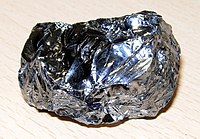
Photo from wikipedia
This study aimed to assess the cytotoxic effect of low molecular weight components (LMWC) and conventional silicone oils (SOs) 1000 cSt with different degree of purification (raw, intermediate, and purified) using… Click to show full abstract
This study aimed to assess the cytotoxic effect of low molecular weight components (LMWC) and conventional silicone oils (SOs) 1000 cSt with different degree of purification (raw, intermediate, and purified) using in vitro cytotoxicity tests. Direct contact cytotoxicity tests were performed in BALB 3T3 and human retinal pigment epithelial cells (ARPE-19) using quantitative and qualitative evaluation according to the ISO 10993-5 (2009) standards. Conventional SOs 1000 cSt in form of raw, intermediate (intermediate product obtained during distillation process), and purified SO (final product after distillation) and a concentrate of LMWC (including siloxane chains with molecular weight up to 1557 g/mol) were directly applied to 100% of cell layer area for 24 h. Cell viability was quantified using 3-(4,5-dimethylthiazole-2-yl)-2,5-28 diphenyltetrazolium bromide (MTT) and neutral red uptake assays in ARPE-19 and BALB3T3, respectively. All tested samples, including the concentrate of LMWC, resulted to be not cytotoxic according to ISO 10993-5 in both qualitative and quantitative evaluations. However, the cellular viability was significantly higher in the intermediate and purified SO compared with the raw SO in ARPE-19 cells. No reduction in cell viability was detected by LMWC. The absence of cytotoxicity was observed for all tested samples in both BALB3T3 and ARPE-19 after 24 h of application. A direct cytotoxic effect is not likely to be involved in the potential complications related to SO and LMWC. Long-term potential adverse effects of SO could be related to the raw material and to different concentrations of LMWC.
Journal Title: Experimental eye research
Year Published: 2020
Link to full text (if available)
Share on Social Media: Sign Up to like & get
recommendations!